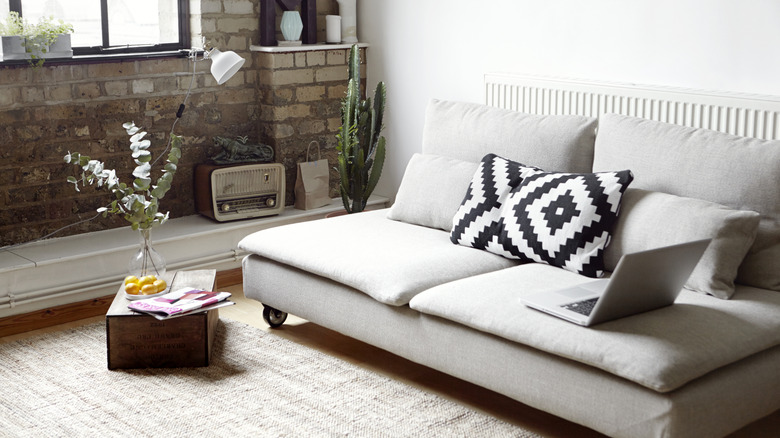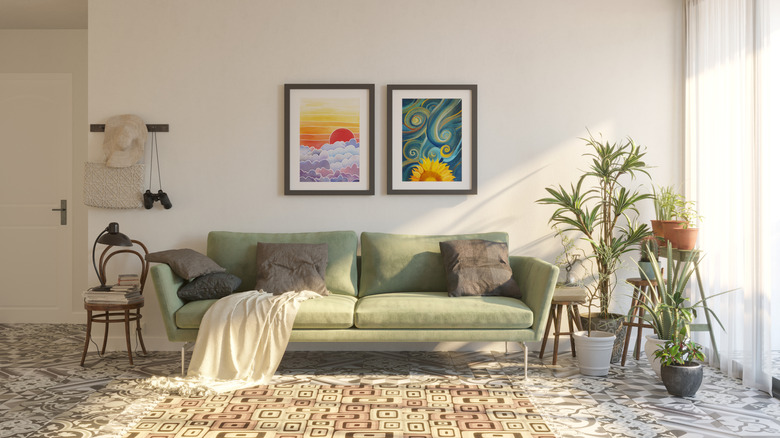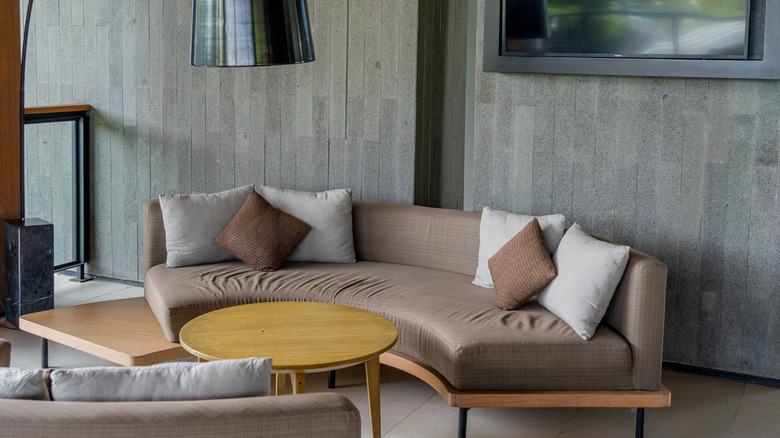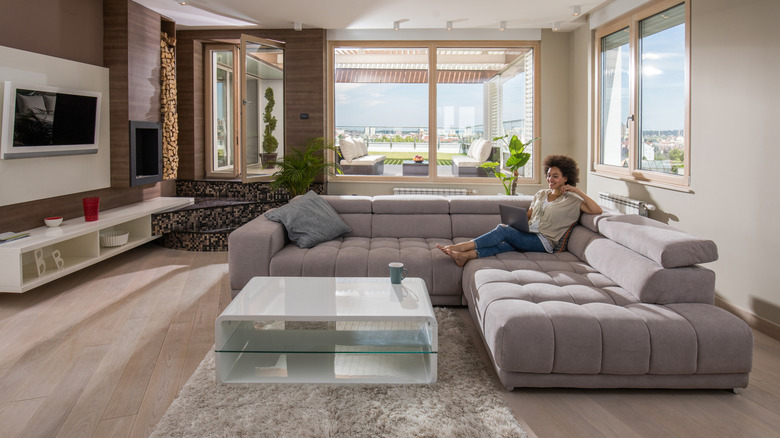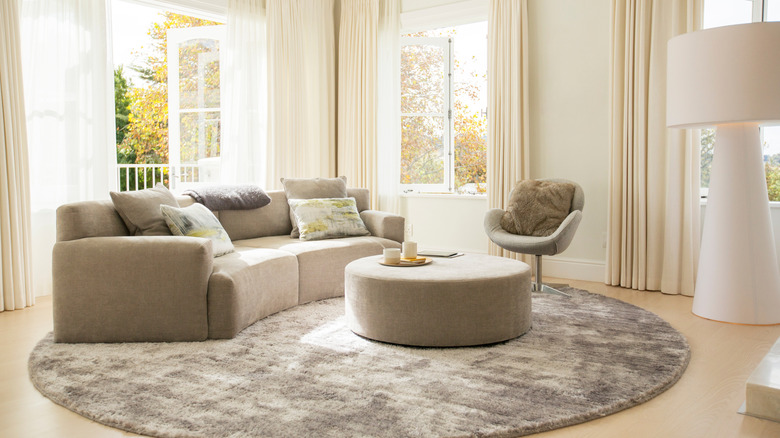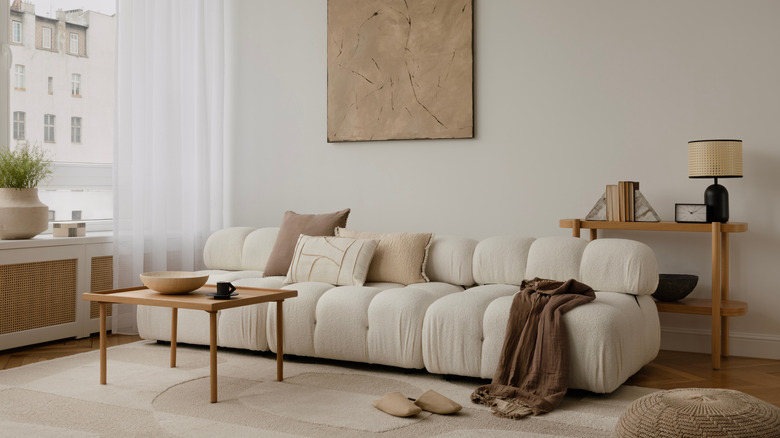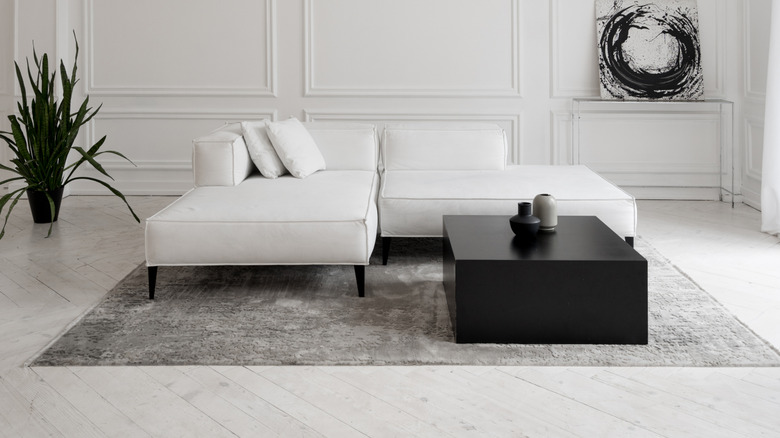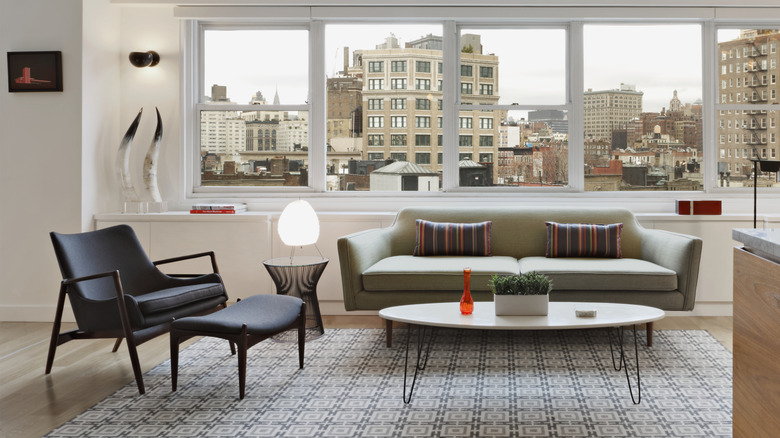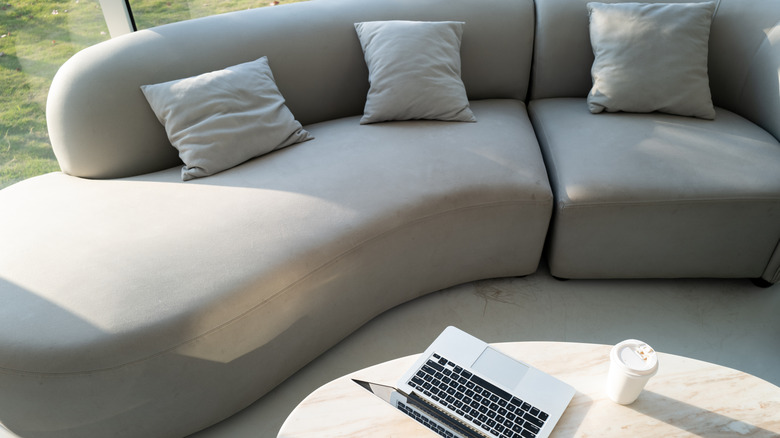10 Tips For Choosing The Right Sofa Shape For Your Living Room
Need a new sofa? Maybe your cat scratched the old one, or perhaps it became a victim of fashion over function. Whatever the reason, you need to pay special attention to the sofa shape. While it's tempting to choose based purely on style and decor, there are a lot of factors that can influence the shape that's best for your space. For instance, what other shapes do you have in your room? Is your living room open concept and sprawling, or small and narrow? Do you love to entertain, or do you live alone and don't often have guests? Perhaps you have gorgeous views or a stunning fireplace you want to pull focus to? All of these factors will influence what shape you should invest in.
And if you want to avoid overspending on a sofa and lamenting it later, you should weigh them seriously. After all, you have so many options — from the classic rectangle shape to L-shaped, curved, U-shaped, low-back, high-arm sofas, and more. To help you choose wisely, House Digest spoke exclusively with six experts and asked them for tips to help you choose the right sofa shape for your living room. So, keep reading to find your perfect fit and avoid a common mistake when designing your living room.
Choose your sofa shape based on your room size
The size of your room will dictate the size of your sofa — the smaller or narrower the room, the smaller the couch. "If you're working with a smaller layout, the most obvious thing that makes a living room feel cramped is a sectional sofa that is way too big," Peter Spalding, CCO and co-founder of designer marketplace Daniel House Club, exclusively tells House Digest. "I see these very often and I never see them filled with all the people one assumes they could accommodate."
Instead, if your space is limited, look for streamlined silhouettes."For longer, narrow rooms, a standard straight sofa might work best," Malak Bellajdel, in-house interior design expert at Metal Plex, shares. While you want to look for a piece with straight, clean lines, you also want to look at the shape of the cushions. To avoid making your room look cramped, steer clear of "a sofa that's padded to the brim," notes Spalding. "If a piece is well constructed, its profile can be very slim and taut and still cradle your body."
Choose your sofa shape based on your room flow
When choosing your sofa shape, you not only have to consider the size of your room, but also its general traffic flow. Essentially, you don't want to choose a shape that will obstruct any natural pathways. "An angular sectional might look stunning in a catalog, but if it blocks natural pathways or creates awkward navigation around your living space, it becomes a design failure," Shiva Samiei, interior designer and CEO of Shiva Samiei & Co., exclusively tells House Digest.
Observe how people move around the living room, including the entry points, exits, walkways, coffee tables, planters, and other furniture. Then, see if the couch you have in mind will fit in between all of the furniture you have, or if it will shrink those pathways and make them difficult to navigate. "Just remember, you want at least 18 inches between your sofa and coffee table for comfortable leg space and more breathing room," Bellajdel notes.
To avoid making a mistake, Bellajdel suggests a simple tip: "A great trick is to use painter's tape to outline different sofa shapes on your floor. Walk around it for a day or two and you'll quickly notice if that L-shaped sectional you've been eyeing might actually be a pain to move around." If it seems like everything from the sectional to the curved couch is too cramped, Samiei suggests choosing a simple, straight sofa. "A classic rectangular sofa with clean lines often provides the most versatile solution, allowing smooth movement and maintaining an open, welcoming atmosphere, she shares.
Use your sofa to match existing shapes in the room
When selecting a sofa shape, consider the furniture and fixtures already in your living room. Samiei explains, "Think of your sofa as a conductor orchestrating a visual symphony — it should both stand out and blend seamlessly with the room's existing design language."
Check whether architectural features, such as windows, doors, fireplaces, accent chairs, or any other furniture your living room needs, complement the sofa shape or not. "If you have rounded coffee tables or circular area rugs, a curved or rounded sofa can create a beautiful visual harmony. Conversely, if your existing pieces feature sharp, geometric lines, a structured rectangular or square sofa will complement that aesthetic," Samiei recommends.
Opt for a low-back sofa if you want to highlight any views
A low-back sofa is an excellent choice for rooms with large windows, outdoor gardens, or scenic landscapes. These views are typically the focal point of a room, so blocking a portion of the window with a high-backed sofa — no matter how attractive — will detract from the feature. Instead, a low-back sofa that sits even with the windowsill will create a seamless connection between your indoor and outdoor spaces.
"If you've got a killer view or want to highlight another feature, like a fireplace or big windows, pick out a low-back sofa that won't steal the spotlight!" InHance Principal Designer Bre Hance tells House Digest. The standard back height for most comfortable sofas is between 26 to 32 inches high. Since windows need to be a minimum of 24 inches from the floor, choosing a 26-inch option will give you the most minimal obstruction.
Choose a curved sofa if you have an open floor plan
Open floor plans can be tricky to style, especially if you have a hard time transitioning from "room" to "room". If your layout feels choppy and disjointed, a curved couch may help. Bree Steele, interior designer and trades account manager at RJ Living, tells House Digest, "If you have an open living/dining/kitchen space, curved sofas are great for keeping that sense of flow, while also defining areas in an open-plan space without harsh lines or bulky dividers." The smooth, flowing design encourages visual harmony and provides a seamless transition to other elements in the space.
It's also a great way to make an open floor plan feel cozier. One of the main gripes of open concept homes is that they can often feel too cavernous and sometimes impersonal. But curved furniture can fix that. Nicole Saunders, interior design specialist and founder of The Design Build Vault, explains to House Digest, "A curved sofa can create a cozy and inviting atmosphere for intimate gatherings." Its cocoon-like shape brings everyone closer together rather than keeping them sprawled apart like an L-shaped sectional might, making the area feel more homey.
If you need flexibility in your room, consider a modular sofa
Modular, or sectional, sofas are designed with multiple components, adding an element of versatility if you're pressed for space, need to grow or subtract your seating regularly, or just like to rearrange your home routinely. "For families or those who love to rearrange their space, a modular sofa is a great option. This means that the sofa can be reconfigured to suit different layouts for different occasions, whether you're hosting guests or just having a cozy movie night. This is especially useful in multipurpose living rooms," elaborates Steele.
Modular sofas are particularly great for multipurpose living rooms. The adaptability of modular sofas eliminates the need to buy extra furniture for special occasions, making it a more cost-effective solution. For larger rooms, place them away from the walls for a luxurious look. This setup also provides a 360-degree view of the room and encourages social interaction from all angles. Modular sofas come in a variety of designs and styles to suit your preferences, with the U- and L-shaped being the most popular. Choose the one that offers you the most flexibility, while also allowing you to walk around easily.
If you're cramped for space, try a chaise-end couch
Chaise-end sofas, or chaise lounges, are as old as ancient Egyptian tombs. We'll spare you the history lesson, but know that while they were once a symbol of luxury, they're now considered the perfect addition to a small space. "If you have a compact living room but still want that 'put-your-feet-up' comfort, a chaise end sofa is a great option," Steele tells us. "It provides the same lounging experience as a larger sofa, but takes up less floor space." The most distinguishing feature of a chaise-end sofa, is, of course, its lounge extension at one end, which lacks a backrest. Because it's not as bulky as a traditional sofa, it looks like it takes up less room in a cramped space. It's an excellent trick to make a sofa work seamlessly in your small living room.
Just make sure it aligns with the room's purpose. Saunders explains, "If the room serves as a quiet retreat, a chaise sectional or a two-seater with an ottoman can provide comfort and intimacy. The sofa shape should reflect the room's purpose and your preferred style of socializing." So what does this mean? If you live alone and don't host many guests, this is a great addition to your living room. Something like IKEA's chaise lounge with customizable storage is a great pick. But if you like to host happy hours or have a large family living in a small house, this might not be the most practical pick.
If you want to create a sense of airiness in your room, try a slim-profile sofa
Just because you have a medium-sized living room doesn't mean you're obligated to stuff every square inch of it with "things." If you want to accent the size of the space and keep a sense of airiness in it, choosing something bulky like an L-shaped sectional or an overstuffed 3-seater with rounded arms isn't going to help your cause. Instead, focus on slim-profile sofas. "For living rooms that aren't tiny but still need to feel spacious, slim-profile sofas with tapered legs can do wonders," Steele explains. "Their streamlined silhouette makes the space feel open and light while still offering plenty of seating. These shapes are particularly effective when you want to balance functionality and aesthetics."
You'll not only have enough space to seat all your guests or family members, but you'll also keep that sense of spaciousness. From an aesthetic perspective, these sofas will likely mimic mid-century modern design. Mid-century modern home decor originated at a time when homes were becoming more utilitarian and less frivolous. Essentially, they were inspired by German Bauhaus design, so they are known for their clean lines and practical functionality. Look for pieces with straight, low backs, boxy armrests, and tall tapered legs.
If you love entertaining, consider U-shaped sofas
Do you have a large family and love hosting? If so, a U-shaped sofa might be just what you need. "I have found a U-shaped sofa ideal for fostering conversation and creating an inclusive environment for households that enjoy entertaining," Saunders adds. The two arms in the U-shaped sofa branch out from the central seating area, allowing people to both mingle with those across, diagonally, and next to them.
They're especially handy if you love entertaining and have an open floor plan. As previously mentioned, it can be difficult to carve out and separate spaces in an open concept home. The large U-shaped sofa can act as a natural divider, thanks to its two vertical arms. This will help create space for an adjoining dining area or a second seating area. It helps define zones and improves the flow of the room. They also can have added functional features that a host might enjoy, such as built-in storage for extra pillows and blankets in case you need to increase the ambiance, chaise lounges perfect for viewing parties, or recliners if you prefer to host more casual functions.
If you have a '70s-inspired living room, go for a low-slung sofa
The '70s are making a comeback. The era's decor featured funky patterns, earthy color palettes, eye-catching shapes, and rich textures. It's fun, nostalgic, and full of feel-good vibes. And if that describes your home decor's theme, then consider a low-slung sofa. "If you're looking to achieve a '70s interior aesthetic, a key piece of furniture is a sofa that's low-slung, maybe a little curvaceous, and ideally defining the perimeter of a conversation pit," Spalding shares. Low-slung sofas are wider and have a lower height, giving your living room a more relaxed and less formal feel. Plus, they don't overwhelm the space and can make the ceilings appear taller, which is especially great if your room has low ceilings.
Opt for a sofa in an earthy tone, such as deep brown or mustard yellow, to bring a natural vibe to your space. Then, pair it with shag rugs in creams, printed pillows in greens, and vintage table lamps in oranges to create a wholesome and natural ambiance. And after all, the '70s were all about bold choices and celebrating individuality, so go wild and celebrate yours.

